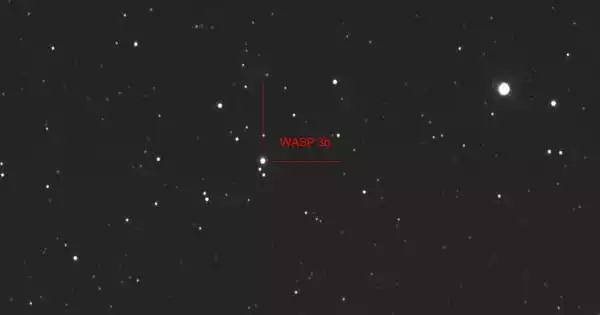WASP-3 b is a gas giant exoplanet in the habitable zone of an F-type star. It is an extrasolar planet that orbits the star WASP-3, which is located about 800 light-years away in the constellation Lyra. It has a mass of 2.43 Jupiters, takes 1.8 days to complete one orbit around its star, and is 0.0315 AU away from it.
It was discovered in 2007 and was announced at the time. SuperWASP discovered it using the transit method, and subsequent radial velocity observations confirmed that WASP-3b is a planet. The mass and radius of the planet indicate that it is a gas giant with a bulk composition similar to Jupiter. The photometric observations used in this study come from the inaugural 2004 SuperWASP-N observing season, which lasted from April to September of that year and resulted in the discovery of WASP-1b and WASP-2b.
WASP-3b has an orbital distance around its star that places it in the category of planets known as hot Jupiters, and its atmospheric temperature is around 1983 K. There are three major competing theories regarding Hot-Jupiter migration. According to the first, migration occurs as a result of tidal interactions between the planet and the protoplanetary disc, which causes some of the planet’s angular momentum to be lost to the disc. The second proposes that gravitational scattering between multiple planets in a system can cause one planet to migrate inwards while the other is ejected from the system.
WASP-3b undergoes no detectable gravitational tugging from other bodies in this system. The study in 2012, utilizing a Rossiter–McLaughlin effect, has determined the planetary orbit is probably aligned with the equatorial plane of the star, misalignment equal to 3.3+2.5-4.4.

In recent years, the field of exoplanets has been blessed with an impressive flow of new and exciting discoveries. As the number of known exoplanetary systems grows, several intriguing features emerge, posing new challenges to theories of planet formation and evolution.
WASP-3b is a hot Jupiter planet with a mass of 2.00 ± 0.09 Mjup that revolves around an F7–8V main-sequence star with a period of ∼1.8 days. The WASP Consortium announced its discovery in 2008 as a result of a photometric campaign conducted with the robotically controlled WASP-North Observatory in La Palma and subsequent radial velocity follow-up obtained with the SOPHIE spectrograph at the Observatory de Haute-Provence. The first photometry of WASP-3b was presented in Pollacco et aldiscovery .’s paper, which used SuperWASP-N along with IAC 80-cm and Keele 80-cm telescope data to refine the transiting object’s properties.
















